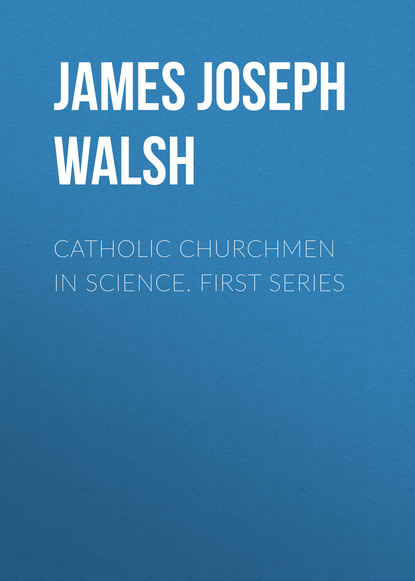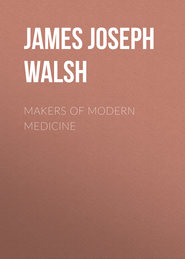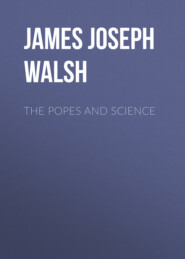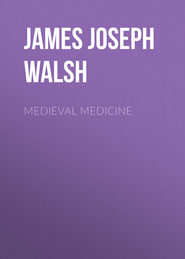По всем вопросам обращайтесь на: info@litportal.ru
(©) 2003-2024.
✖
Catholic Churchmen in Science. First Series
Настройки чтения
Размер шрифта
Высота строк
Поля
These thoughts seem to have attracted many promising young men to the study of medicine. The result was a period of writing and active observation in medicine that undoubtedly makes this one of the most important of literary medical eras. Some idea of the activity of the writers of the time can be gathered from the important medical books–most of them large folios which were printed during the last half of the sixteenth century in Italy. There is a series of these books to be seen in one of the cases of the library of the Surgeon-General at Washington, which, though by no means complete, must be a source of never-ending surprise to those who are apt to think of this period as a saison morte in medical literature.
There must have been an extremely great interest in medicine to justify all this printing. Some of the books are among the real incunabula of the art of printing. For instance, in 1474 there was published at Bologna De Manfredi's "Liber de Homine;" at Venice, in 1476, Petrus de Albano's work on medicine; and in the next twenty years from the same home of printing there came large tomes by Angelata, a translation of Celsus, and Aurelius Cornelius and Articellus's "Thesaurus Medicorum Veterum," besides several translations of Avicenna and Platina's work "De Honesta Voluptate et Valetudine." At Ferrara, Arculanus's great work was published, while at Modena there appeared the "Hortus Sanitatis," or Garden of Health, whose author was J. Cuba. There were also translations from other Arabian authors on medicine in addition to Avicenna, notably a translation of Rhazes Abu Bekr Muhammed Ben Zankariah Abrazi, a distinguished writer among the Arabian physicians of the Middle Ages.
Linacre's translations of Galen remain still the standard, and they have been reprinted many times. As Erasmus once wrote to a friend, in sending some of these books of Galen, "I present you with the works of Galen, now by the help of Linacre speaking better Latin than they ever before spoke Greek." Linacre also translated Aristotle into Latin, and Erasmus paid them the high compliment of saying that Linacre's Latin was as lucid, as straightforward, and as thoroughly intelligible as was Aristotle's Greek. Of the translations of Aristotle unfortunately none is extant. Of Galen we have the "De Sanitate Tuenda," the "Methodus Medendi," the "De Symptomatum Differentiis et Causis," and the "De Pulsuum Usu." The latter particularly is a noteworthy monograph on an important subject, in which Galen's observations were of great value. Under the title, "The Significance of the Pulse," it has been translated into English, and has influenced many generations of English medical men.
While we have very few remains of Linacre's work as a physician, there seems to be no doubt that he was considered by all those best capable of judging, to stand at the head of his profession in England. To his care, as one of his biographers remarked, was committed the health of the foremost in Church and State. Besides being the Royal Physician, he was the regular medical attendant of Cardinal Wolsey, of Archbishop Warham, the Primate of England, of Richard Fox, Bishop of Winchester, the Keeper of the Privy Seal, and of Sir Reginald Bray, Knight of the Garter and Lord High Treasurer, and of all of the famous scholars of England.
Erasmus, whilst absent in France, writes to give him an account of his feelings, and begs him to prescribe for him, as he knows no one else to whom he can turn with equal confidence. After a voyage across the channel, during which he had been four days at sea–making a passage by the way that now takes less than two hours–Erasmus describes his condition, his headache, with the glands behind his ears swollen, his temples throbbing, a constant buzzing in his ears; and laments that no Linacre was at hand to restore him to health by skilful advice. In a subsequent letter he writes from Paris to ask for a copy of a prescription given him while in London by Linacre, but which a stupid servant had left at the apothecary shop, so that Erasmus could not have it filled in Paris.
An instance of his skill in prognosis, the most difficult part of the practice of medicine according to Hippocrates and all subsequent authorities, is cited by all his biographers, with regard to his friend William Lily, the grammarian. Lily was suffering from a malignant tumor involving the hip, which surgeons in consultation had decided should be removed. Linacre plainly foretold that its removal would surely prove fatal, and the event verified his unfavorable prognosis. Generally it seems to have been considered that his opinion was of great value in all serious matters, and it was eagerly sought for. Some of the nobility and clergy of the time came even from the Continent over to England by no means an easy journey, even for a healthy man in those days, as can be appreciated from Erasmus's experience just cited–in order to obtain Linacre's opinion.
One of Erasmus's letters to Billibaldus Pirckheimer contains a particular account of the method of treatment by which he was relieved of his severe pain under Linacre's direction in a very tormenting attack of renal colic. The details, especially the use of poultice applications as hot as could be borne, show that Linacre thoroughly understood the use of heat in the relaxation of spasm, while his careful preparation of the remedies to be employed in the presence of the patient himself would seem to show that he had a very high appreciation of how much the mental state of the patient and the attitude of expectancy thus awakened may have in giving relief even in cases of severe pain.
The only medical writings of Linacre's that we possess are translations. We have said already that the reversion at the end of the fifteenth century to the classical authorities in medicine undoubtedly did much to introduce the observant phase of medical science, which had its highest expression in Vesalius at the beginning of the sixteenth century and continued to flourish so fruitfully during the next two centuries at most of the Italian universities. His translations then were of themselves more suggestive contributions to medicine than would perhaps have been any even of his original observations, since the mind of his generation was not ready as yet to be influenced by discoveries made by contemporaries.
The best proof of Linacre's great practical interest in medicine is his realization of the need for the Royal College of Physicians and his arrangements for it.
The Roll of the College, which comprises biographical sketches of all the eminent physicians whose names are recorded in the annals from the foundation of the College in 1518, and is published under the authority of the College itself, contains the best tribute to Linacre's work that can possibly be paid. It says: "The most magnificent of Linacre's labors was the design of the Royal College of Physicians of London–a standing monument of the enlightened views and generosity of its projectors. In the execution of it Linacre stood alone, for the munificence of the Crown was limited to a grant of letters patent; whilst the expenses and provision of the College was left to be defrayed out of his own means, or of those who were associated with him in its foundation." "In the year 1518," says Dr. Johnson[7 - Life of Linacre, London, 1835.], "when Linacre's scheme was carried into effect, the practice of medicine was scarcely elevated above that of the mechanical arts, nor was the majority of its practitioners among the laity better instructed than the mechanics by whom these arts were exercised. With the diffusion of learning to the republics and states of Italy, establishments solely for the advancement of science had been formed with success; but no society devoted to the interests of learning yet existed in England, unfettered by a union with the hierarchy, or exempted from the rigors and seclusions which were imposed upon its members as the necessary obligation of a monastic and religious life. In reflecting on the advantages which had been derived from these institutions, Linacre did not forget the impossibility of adapting rules and regulations which accorded with the state of society in the Middle Ages to the improved state of learning in his own, and his plans were avowedly modelled on some similar community of which many cities of Italy afforded rather striking examples."
Some idea of the state into which the practice of medicine had fallen in England before Linacre's foundation of the Royal College of Physicians may be gathered from the words of the charter of the College. "Before this period a great multitude of ignorant persons, of whom the greater part had no insight into physic, nor into any other kind of learning–some could not even read the letters on the book, so far forth that common artificers as smiths, weavers and women–boldly and accustomably took upon them great cures to the high displeasure of God, great infamy to the faculty, and the grievous hurt, damage, and destruction of many of the King's liege people."
After the foundation of the College there was a definite way of deciding formally who were, or were not, legally licensed to practise. As a consequence, when serious malpractice came to public notice, those without a license were occasionally treated in the most summary manner. Stowe, in his chronicles, gives a very vivid and picturesque description of the treatment of one of these quacks who had been especially flagrant in his imposition upon the people. A counterfeit doctor was set on horseback, his face to the horse's tail, the tail being forced into his hand as a bridle, a collar of jordans about his neck, a whetstone on his breast, and so led through the city of London with ringing of basins, and banished. "Such deceivers," continued the old chronicler, "no doubt are many, who being never trained up in reading or practice of physics and Chirurgery do boast to do great cures, especially upon women, as to make them straight that before were crooked, corbed, or crumped in any part of their bodies and other such things. But the contrary is true. For some have received gold when they have better deserved the whetstone." [8 - "To get the whetstone" is an old English expression, meaning to take the prize for lying. It is derived from the old custom of driving rogues, whose wits were too sharp, out of town with a whetstone around their necks.]Human nature has not changed very much in the four centuries since Linacre's foundation, and while the model that he set in the matter of providing a proper licensing body for physicians has done something to lessen the evils complained of, the abuses still remain; and the old chronicler will find in our time not a few who, in his opinion, might deserve the whetstone. We can scarcely realize how much Linacre accomplished by means of the Royal College of Physicians, or how great was the organizing spirit of the man to enable him to recognize the best way out of the chaos of medical practice in his time.
"The wisdom of Linacre's plan," wrote Dr. Friend, "speaks for itself. His scheme, without doubt, was not only to create a good understanding and unanimity among his own profession (which of itself was an excellent thought), but to make them more useful to the public. And he imagined that by separating them from the vulgar empirics and setting them upon such a reputable foot of distinction, there would always arise a spirit of emulation among men liberally educated, which would animate them in pursuing their inquiries into the nature of diseases and the methods of cure for the benefit of mankind; and perhaps no founder ever had the good fortune to have his designs succeed more to his wish."
His plans with regard to the teaching of medicine at the two great English Universities did not succeed so well, but that was the fault not of Linacre nor of the directions left in his will, but of the times, which were awry for educational matters. Notwithstanding Linacre's bequest of funds for two professorships at Oxford and one at Cambridge, it is typical of the times that the chairs were not founded for many years. During Henry VIII's time, the great effort of government was not to encourage new foundations but to break up old ones, in order to obtain money for the royal treasury, so that educational institutions of all kinds suffered eclipse. The first formal action with regard to the Linacre bequest was taken in the third year of Edward VI. Two lectureships were established in Merton College, Oxford, and one in St. John's College, Cambridge. Linacre's idea had been that these foundations should be University lectureships, but Anthony Wood says that the University had lost in prestige so much during Henry VIII's time that it was considered preferable to attach the lectureships to Merton College, which had considerable reputation because of its medical school. During Elizabeth's time these Linacre lectureships sank to be sinecures and for nearly a hundred years served but for the support of a fellowship. The Oxford foundation was revived in 1856 by the University Commissioners, and the present splendid foundation of the lectures in physiology bears Linacre's name in honor of his original grant.
At the age of about fifty Linacre was ordained priest. His idea in becoming a clergyman, as confessed in letters to his friends, was partly in order to obtain leisure for his favorite studies, but also out of the desire to give himself up to something other than the mere worldly pursuits in which he had been occupied during all his previous life. His biographer, Dr. Johnson, says: "In examining the motives of this choice of Linacre's, it would seem that he was guided less by the expectation of dignity and preferment than by the desire of retirement and of rendering himself acquainted with those writings which might afford him consolation in old age and relief from the infirmities which a life of assiduous study and application had tended to produce."
The precise time of Linacre's ordination is not known, nor is it certain whether he was ordained by Archbishop Warham of Canterbury, or by Cardinal Wolsey, the Archbishop of York. He received his first clerical appointment from Warham, by whom he was collated to the rectory of Mersham in Kent. He held this place scarcely a month, but his resignation was followed by his installation as prebend in the Cathedral of Wells, and by an admission to the Church of Hawkhurst in Kent, which he held until the year of his death. Seven years later he was made prebend in the Collegiate Chapel of St. Stephen, Westminster, and in the following year he became prebendary of South Newbold in the Church of York. This was in the year 1518. In the following year he received the dignified and lucrative appointment of presenter to the Cathedral of York, for which he was indebted to Cardinal Wolsey, to whom about this time he dedicated his translation of Galen "On the Use of the Pulse." He seems also to have held several other benefices during the later years of his life, although some of them were resigned within so short a time as to make it difficult to understand why he should have accepted them, since the expenses of institution must have exceeded the profits which were derived from them during the period of possession. Linacre owed his clerical opportunities during the last years of his life particularly to Archbishop Warham, who, as ambassador, primate, and chancellor, occupied a large and honorable place in the history of the times. Erasmus says of him in one of his letters: "Such were his vigilance and attention in all matters relating to religion and to the offices of the Church that no concern which was foreign to them seemed ever to distract him. He had sufficient time for a scrupulous performance of the accustomed exercises of prayer, for the almost daily celebration of the Mass, for twice or thrice hearing divine service, for determining suits, for receiving embassies, for consultation with the king when matters of moment required his presence, for the visitation of churches when regulation was needed, for the welcome of frequently two hundred guests, and lastly for a literary leisure."
As the close friend of such men, it is evident that Linacre must have accomplished much good as a clergyman; and it seems not unlikely that his frequent changes of rectorship were rather due to the fact that the Primate wished to make use of his influence in various parts of his diocese for the benefit of religion than for any personal motives on Linacre's part, who, in order to enter the service of the Church, had given up so much more than he could expect as a clergyman.
Linacre as a clergyman continued to deserve the goodwill and esteem of all his former friends, and seems to have made many new ones. At the time of his death he was one of the most honored individuals in England. All of his biographers are agreed in stating that he was the representative Englishman of his time, looked up to by all his contemporaries, respected and admired by those who had not the opportunity of his intimate acquaintance, and heartily loved by friends, who were themselves some of the best men of the time.
The concluding paragraph of the appreciation of Linacre's character in Lives of British Physicians[9 - London. John Murray, 1830.] is as follows: "To sum up his character it was said of him that no Englishman of his day had had such famous masters, namely, Demetrius and Politian of Florence; such noble patrons, Lorenzo de' Medici, Henry VII and Henry VIII; such high-born scholars, the Prince Arthur and Princess Mary of England; or such learned friends, for amongst the latter were to be enumerated Erasmus, Melanchthon, Latimer, Tonstal, and Sir Thomas More." His biographer might have added the names of others of the pre-Reformation period, men of culture and character whose merits only the historical researches of recent years have brought out–Prior Selling, Dean Colet (though his friendship was unfortunately interrupted), Archbishop Warham, Cardinal Wolsey, Grocyn, and further scholars and churchmen.
Dr. J. F. Payne, in summing up the opinion of Linacre held by his contemporaries, in the "Dictionary of National Biography" (British), pays a high tribute to the man. "Linacre's personal character was highly esteemed by his contemporaries. He was evidently capable of absolute devotion to a great cause, animated by genuine public spirit and a boundless zeal for learning." Erasmus sketches him humorously in the "Encomium Moriae" (The Praise of Foolishness)–with a play on the word Moriae in reference to his great friend, Thomas More, of whom Erasmus thought so much–showing him a tireless student. The distinguished foreign scholar, however, considered Linacre as an enthusiast in recondite studies, but no mere pedant. Dr. Payne closes his appreciation with these words: "Linacre had, it would seem, no enemies."
Caius, the distinguished English physician and scholar, himself one of the best known members of the Royal College of Physicians and the founder of Caius College, Cambridge, sketches Linacre's character (he had as a young man known him personally) in very sympathetic vein. As Dr. Caius was one of the greatest Englishmen of his time in the middle of the sixteenth century, his opinion must carry great weight. It is to him that we owe the famous epitaph that for long in old St. Paul's, London, was to be read on Linacre's tombstone:–
"Fraudes dolosque mire perosus, fidus amicis, omnibus ordinibus juxta carus. A stern hater of deceit and underhand ways, faithful to his friends, equally dear to all classes,"
Surely this is a worthy tribute to the great physician, clergyman, scholar, and philanthropist of the eve of the Reformation in England.
V.
FATHER KIRCHER, S.J.:
SCIENTIST, ORIENTALIST, AND COLLECTOR
Oportet autem neque recentiores viros in his fraudare quae vel repererunt vel recte secuti sunt; et tamen ea quae apud antiquiores aliquos posita sunt auctoribus suis reddere.–CELSUS de Medicina.
V.
FATHER KIRCHER, S.J.: SCIENTIST, ORIENTALIST, AND COLLECTOR
Except in the minds of the unconquerably intolerant, the Galileo controversy has in recent years settled down to occupy something of its proper place in the history of the supposed conflict between religion and science. In touching the subject in the life of Copernicus we suggested that it has come to be generally recognized, as M. Bertrand, the perpetual Secretary of the Paris Academy of Sciences, himself a distinguished mathematician and historian, declares, that "the great lesson for those who would wish to oppose reason with violence was clearly to be read in Galileo's story, and the scandal of his condemnation was learned without any profound sorrow to Galileo himself; and his long life, considered as a whole, was the most serene and enviable in the history of science." Somehow, notwithstanding the directness of this declaration, there is still left in the minds of many an impression rather difficult to eradicate that there was definite, persistent opposition to everything associated with scientific progress among the churchmen of the time of Galileo.
Perhaps no better answer to this unfortunate, because absolutely untrue, impression could be in formulated than is to be found in a sketch of the career of Father Athanasius Kircher, the distinguished Jesuit who for so many years occupied himself with nearly every branch of science in Rome, under the fostering care of the Church. He had been Professor of Physics, Mathematics, and Oriental Languages at Würzburg, but was driven from there by the disturbances incident to the Thirty Years' War, in 1631. He continued his scientific investigation at Avignon. From here, within two years after Galileo's trial in 1635, he was, through the influence of Cardinal Barberini, summoned to Rome, where he devoted himself to mathematics at first, and then to every branch of science, as well as the Oriental languages, not only with the approval, but also with the most liberal pecuniary aid from the ecclesiastical authorities of the papal court and city.
Some idea of the breadth of Father Kircher's scientific sympathy and his genius for scientific observation and discovery, which amounted almost to intuition, may be gathered from the fact that to him we owe the first definite statement of the germ theory of disease; and he seems to have been the first to recognize the presence of what are now called microbes. At the same time his works on magnetism contained not only all the knowledge of his own time, but also some wonderful suggestions as to the possibilities of the development of this science. His studies with regard to light are almost as epochal as those with regard to magnetism. Besides these, he was the first to find any clue to the Egyptian hieroglyphics, and yet found time to write a geographical work on Latium, the country surrounding Rome, and to make collections for his museum which rendered it in its time the best scientific collection in the world. It may very well indeed be said that visitors to Rome with scientific tendencies found as much that was suggestive in Father Kircher's museum–the "Kircherianum," as it came to be called–as artists and sculptors and architects found in the Vatican collections of the papal city.
All of this work was accomplished within the half century after Galileo's trial, for Father Kircher died in 1680, at the age of seventy-eight, having lived, as so many of the great scientists have done, a long life in the midst of the most persistent activity. Kircher, more than perhaps any other, can be said to be the founder of modern natural science. Before any one else, in a practical way, he realized the necessity for the collection of an immense amount of data, if science was to be founded on the broad, firm foundation of observed truth. The principle which had been announced by Bacon in the "Novum Organon"–"to take all that comes rather than to choose, and to heap up rather than to register"–was never carried out as fully as by Father Kircher. As Edmund Gosse said in the June number of Harper's, 1904, "Bacon had started a great idea, but he had not carried it out. He is not the founder, he is the prophet of modern physical science. To be in direct touch with nature, to adventure in the unexplored fields of knowledge, and to do this by carrying out an endless course of slow and sure experiments, this was the counsel of the 'Novum Organon.'" Bacon died in 1626, and scarcely more than a decade had passed before Kircher was carrying out the work thus outlined by the English philosopher in a way that was surprisingly successful, even looked at from the standpoint of our modern science. Needless to say, however, it was not because of Bacon's suggestion that he did so, for it is more than doubtful whether he knew of Bacon's writings until long after the lines of his life-work had been traced by his own inquiring spirit. The fulness of time had come. The inductive philosophy was in the air. Bacon's formulae, which the English philosopher never practically applied, and Father Kircher's assiduous collection of data, were but expressions of the spirit of the times. How faithfully the work of the first modern inductive scientist was accomplished we shall see.
It may be easily imagined that a certain interest in Father Kircher, apart from his scientific attainments and the desire to show how much and how successful was the attention given to natural science by churchmen about the time of the Galileo controversy, might influence this judgment of the distinguished Jesuit's scientific accomplishments. With regard to his discoveries in medicine especially, and above all his announcement of the microbic origin of contagious disease, it may be thought that this was a mere chance expression and not at all the result of serious scientific conclusions. Tyndall, however, the distinguished English physicist, would not be the one to give credit for scientific discoveries, and to a clergyman in a distant century, unless there was definite evidence of the discovery. It is not generally known that to the great English physicist we owe the almost absolute demonstration of the impossibility of spontaneous generation, together with a series of studies showing the existence everywhere in the atmosphere of minute forms of life to which fermentative changes and also the infectious diseases–though at that time this was only a probability–are to be attributed. When Tyndall was reviewing, in the midst of the controversy over spontaneous generation, the question of the microbic origin of disease, he said: "Side by side with many other theories has run the germ theory of epidemic disease. The notion was expressed by Kircher and favored by Linnaeus, that epidemic diseases may be due to germs which enter the body and produce disturbance by the development within the body of parasitic forms of life."
How much attention Father Kircher's book on the pest or plague, in which his theory of the micro-organismal origin of disease is put forward, attracted from the medical profession can be understood from the fact that it was submitted to three of the most distinguished physicians in Rome before being printed, and that their testimony to its value as a contribution to medicine prefaced the first edition. They are not sparing in their praise of it. Dr. Joseph Benedict Sinibaldus, who was the Professor of the Practice of Medicine in the Roman University at the time, says that "Father Kircher's book not only contains an excellent resume of all that is known about the pest or plague, but also as many valuable hints and suggestions on the origin and spread of the disease, which had never before been made." He considers it a very wonderful thing that a non-medical man should have been able to place himself so thoroughly in touch with the present state of medicine in respect to this disease and then point out the conditions of future progress.
Dr. Paul Zachias, who was a distinguished Roman physician of the time, said that he had long known Father Kircher as an eminent writer on other subjects, but that after reading his book on the pest he must consider him also distinguished in medical writing. He says: "While he has set his hand at other's harvests, he has done it with so much wisdom and prudence as to win the admiration of the harvesters already in the field." He adds that there can be no doubt that it would be a source of profit for medical men to read this little book and that it will undoubtedly prove beneficial to future generations. Testimony of another kind to the value of Father Kircher's book is to be found in the fact that within a half-year after its publication in Latin it appeared in several other languages. It is too much the custom of these modern times to consider that scientific progress in the centuries before our own and its immediate predecessor was likely to attract little attention for many years, and was especially slow to make its way into foreign countries. Anything, however, of real importance in science took but a very short time to travel from one country to another in Europe in the seventeenth century, and the fact that scientific men generally used Latin as a common language made the spread of discoveries and speculations much easier even than at the present time. Our increased means of communication have really only served to allow sensational announcements of a progress in science–which is usually no progress at all–to be spread quite as effectually in modern times as were real advances in the older days.
There is no good account of Father Kircher's life available in English, and it has seemed only proper that the more important at least of the details of the life of the man who thus anticipated the beginnings of modern bacteriology and of the relations of micro-organisms to disease, should not be left in obscurity. His life history is all the more interesting and important because it illustrates the interest of the churchmen of the time, and especially of the Roman ecclesiastical authorities, in all forms of science; for Father Kircher is undoubtedly one of the greatest scholars of history and one of the scientific geniuses in whose works can be found, as the result of some wonderful principles of intuition incomprehensible to the slower intellectual operations of ordinary men, anticipations of many of the discoveries of the after-time. There is scarcely a modern science he did not touch upon, and nothing that he touched did he fail to illuminate. His magnificent collections in the museum of the Roman College demonstrate very well his extremely wide interests in all scientific matters.
The history of Father Kircher's career furnishes perhaps the best possible refutation of the oft-repeated slander that Jesuit education was narrow and was so founded upon and rooted in authority that original research and investigation, in scientific matters particularly, were impossible, and that it utterly failed to encourage new discoveries of any kind. As a matter of fact, Kircher was not only not hampered in his work by his superiors or by the ecclesiastical authorities, but the respect in which he was held at Rome enabled him to use the influence of the Church and of great churchmen all over the world, with the best possible effect, for the assembling at the Roman College of objects of the most various kinds, illustrating especially the modern sciences of archeology, ethnology, and paleontology, besides Egyptian and Assyrian history.
Athanasius Kircher was born 2 May, 1602, at Geisa, near Fulda, in South Germany. He was educated at the Jesuit College of Fulda, and at the early age of sixteen, having completed his college course, entered the Jesuit novitiate at Mainz. After his novitiate he continued his philosophical and classical studies at Paderborn and completed his years of scholastic teaching in various cities of South Germany–Munster, Cologne, and Coblenz–finally finishing his education by theological studies at Cologne and Mainz.
Toward the end of the third decade of the seventeenth century he became Professor of Philosophy and Mathematics at Würzburg. Here his interest in Oriental languages began, and he established a special course in this subject at the University of Würzburg. During the Thirty Years' War, however, the invasion of Germany very seriously disturbed university work, and finally in 1631 Father Kircher was sent by his superiors to Avignon in South France, where he continued his teaching some four years, attracting no little attention by his wide interest in many sciences and by various scientific works that showed him to be a man of very broad genius.
In 1635, through the influence of Cardinal Barberini, he was summoned to Rome, where he became Professor of Mathematics and Oriental Languages in the famous Roman College of the Jesuits, which was considered at that time one of the greatest educational institutions in the world. His interest in science, however, was not lessened by teaching duties that would apparently have demanded all his time; and, as we shall see, he continued to issue books on the most diverse scientific subjects, most of them illustrated by absolutely new experimental observations and all of them attracting widespread attention.
Father Kircher began his career as a writer on science at the early age of twenty-seven, when he issued his first work on magnetism. The title of this volume, "Ars Magnesia tum Theorematice tum Problematice Proposita," shows that the subject was not treated entirely from a speculative standpoint. Indeed, in the preface he states that he hopes that the principal value of the book will be found in the fact that the knowledge of magnetism is presented by a new method, with special demonstrations, and that the conclusions are confirmed by various practical uses and long-continued experience with magnets of various kinds.
Although it may be a source of great surprise, Father Kircher's genius was essentially experimental. He has been spoken of not infrequently as a man who collected the scientific information of his time in such a way as to display, as says the Encyclopedia Britannica, "a wide and varied learning, but that he was a man singularly devoid of judgment and critical discernment." He was in some respects the direct opposite of the opinion thus expressed, since his learning was always of a practical character, and there are very few subjects in this writing which he has not himself illustrated by means of new and ingenious experiments.
Perhaps the best possible proof of this is to be found in the fact that his second scientific work was on the construction of sun-dials, and that one of the discoveries he himself considered most valuable was the invention of a calculating machine, as well as of a complicated arrangement for illustrating the positions of the stars in the heavens. He constructed, moreover, a large burning-glass in order to demonstrate the possibility of the story told of Archimedes, that he had succeeded in burning the enemy's ships in the harbor at Syracuse by means of a large lens.
But Father Kircher's surest claim to being a practical genius is to be found in his invention of the magic lantern. It was another Jesuit, Aquilonius, in his work on optics, issued in 1613, who had first sought to explain how the two pictures presented to the two eyes are fused into one, and it was in a practical demonstration of this by means of lenses that Kircher hit upon the invention of the projecting stereoscope.
After his call to Rome our subject continued his work on magnetism, and in 1641 issued a further treatise on the subject called "Magnes" or "De Arte Magnetica." While he continued to teach Oriental languages and issued in 1644 a book with the title "Lingua AEgyptiaca Restituta," he also continued to apply himself especially to the development of physical science. Accordingly in 1645 there appeared his volume "Ars Magna Lucis et Umbrae." This was a treatise on light, illustrated, as was his treatise on magnetism, by many original experiments and demonstrations.
During the five years until 1650 the department of acoustics came under his consideration, so that in that year we have from his pen a treatise called "Musurgia Universalis," with the subtitle, "The Art of Harmony and Discord; a treatise on the whole doctrine of sound with the philosophy of music treated from the standpoint of practical as well as theoretic science." During the next five years astronomy was his special hobby, and the result was in 1656 a treatise on astronomy called "Iter Celeste." This contained a description of the earth and the heavens and discussed the nature of the fixed and moving stars, with various considerations as to the composition and structure of these bodies. A second volume on this subject appeared in 1660.
The variety of Father Kircher's interests in science was not yet exhausted, however. Five years after the completion of his two volumes on astronomy there came one on "Mundus Subterraneus." This treated of the modern subjects of geology, metallurgy, and mineralogy, as well as the chemistry of minerals. It also contained a treatise on animals that live under the ground, and on insects. This was considered one of the author's greatest books, and the whole of it was translated into French, whilst abstracts from it, especially the chapters on poisons, appeared in most of the other languages of Europe. Part of it was translated even into English, though seventeenth-century Englishmen were loath to draw their inspiration from Jesuit writers.
Jesuits were, however, at this time generally acknowledged on the Continent to be leaders in every department of thought, sympathetic coadjutors in every step in scientific progress. Strange as it may appear to those who will not understand the Jesuit spirit of love for learning, two of the most distinguished scientists whose names are immortal in the history of physical sciences in different departments during this century, Kepler and Harvey, were on intimate terms of friendship with the Jesuits of Germany. Harvey, on the occasion of a visit to the Continent, stopped for a prolonged visit with the Jesuits at Cologne, so that some of his English friends joked him about the possibility of his making converts of the Jesuits. These witticisms, however, did not seem to distract Harvey very much, for he returned on a subsequent occasion to spend some further days with his Jesuit scientific friends along the Rhine.
In the meantime Father Kircher was issuing notable books on his always favorite subject of the Oriental languages. In 1650 there appeared "Obeliscus Pamphilius," containing an explanation of the hieroglyphics to be found on the obelisk which by the order of Innocent X, a member of the Pamfili family, was placed in the Piazza Navona by Bernini. This is no mere pamphlet, as might be thought, but a book of 560 pages. In 1652 there appeared "OEdipus AEgyptiacus," that is, the revealer of the sphinx-like riddle of the Egyptian ancient languages. In 1653 a second volume of this appeared, and in 1655 a third volume. It was considered so important that it was translated into Russian and other Slav languages, besides several other European languages. His book, "Lingua AEgyptiaca Restituta," which appeared in 1644, when Kircher was forty-two years of age, is considered to be of value yet in the study of Oriental languages, and was dedicated to the patron, Emperor Ferdinand III, whose liberality made its publication possible.











